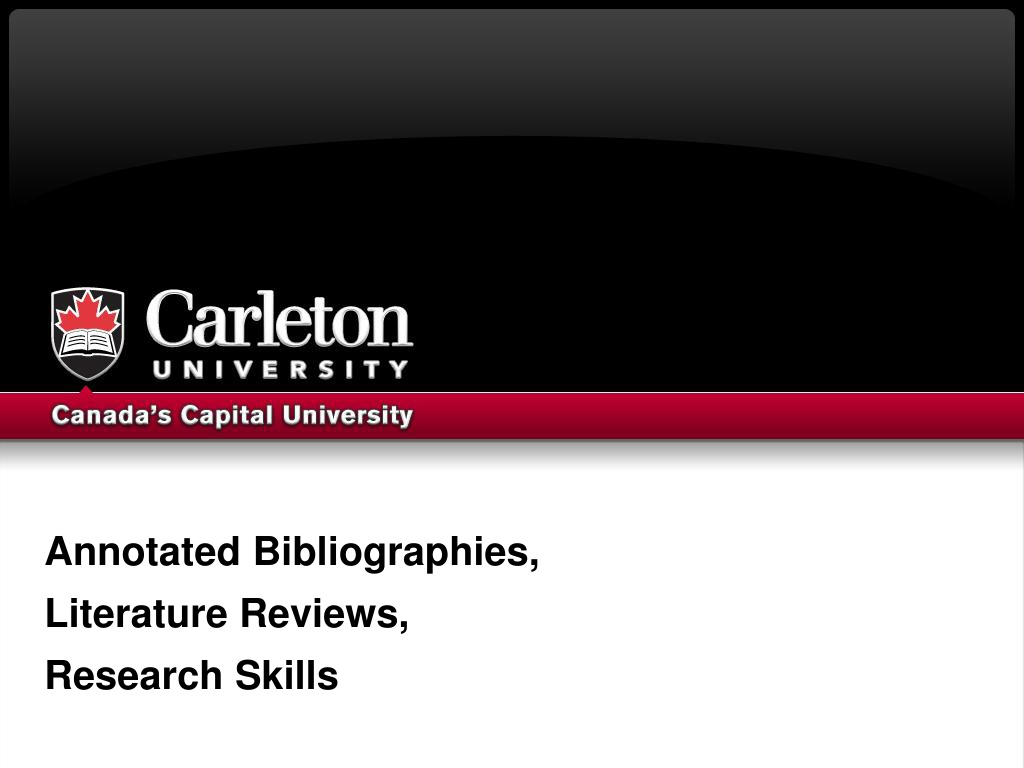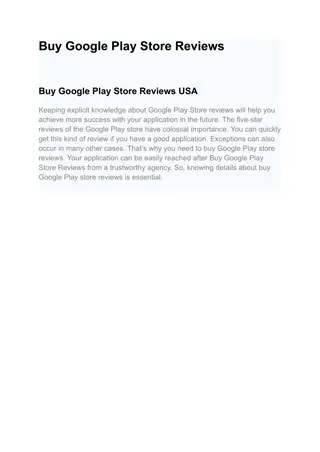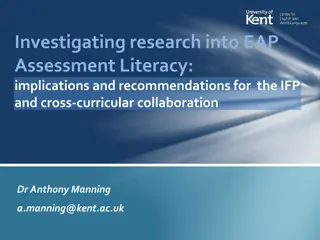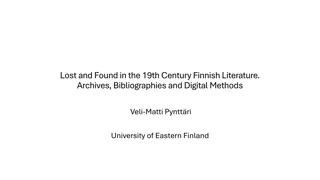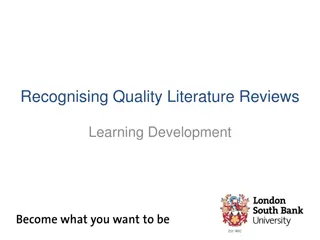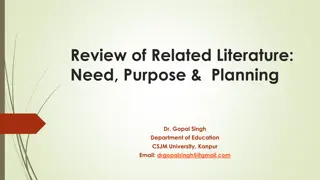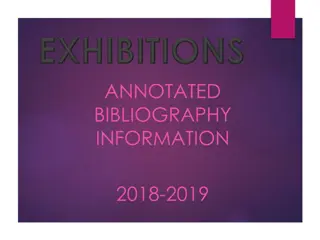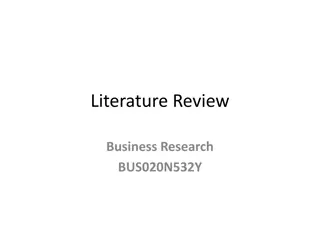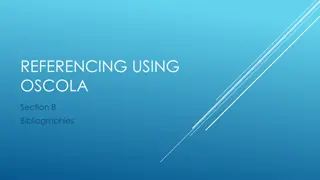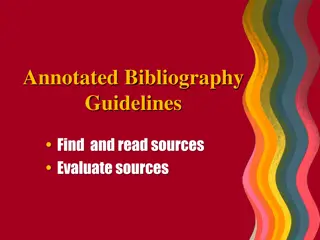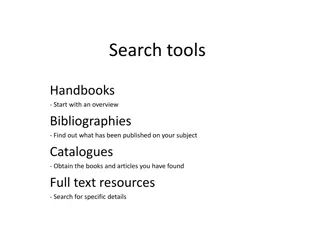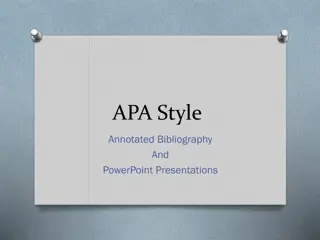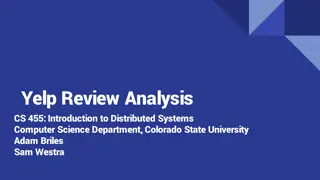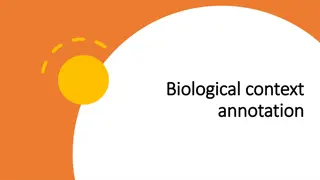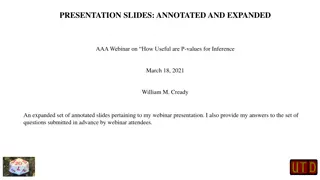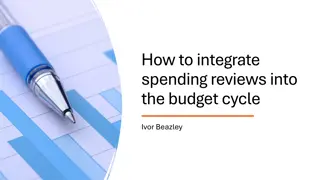Enhancing Research Skills: Annotated Bibliographies and Literature Reviews
Enhance your research skills with techniques such as active reading, annotation, and asking critical questions. Explore strategies for effective literature reviews and annotated bibliographies to improve your understanding and analysis of academic content.
Download Presentation

Please find below an Image/Link to download the presentation.
The content on the website is provided AS IS for your information and personal use only. It may not be sold, licensed, or shared on other websites without obtaining consent from the author. Download presentation by click this link. If you encounter any issues during the download, it is possible that the publisher has removed the file from their server.
E N D
Presentation Transcript
Annotated Bibliographies, Literature Reviews, Research Skills
Outline Active reading Annotated bibliography Literature review Strategies for searching Search tools Citation management
Active Reading Reading something with a determination to understand and evaluate it for its relevance to your needs Simply reading and re-reading the material isn't an effective way to understand and learn Actively and critically engaging with the content https://help.open.ac.uk/active-reading
Techniques Underline or highlight key words/phrases Make annotations in the margin Ask questions as you read Test yourself Look for 'signposts' Explain what you've read to someone else Record yourself and listen https://help.open.ac.uk/active-reading
Questions to ask as you read How well do the methods test the hypothesis? | Is the sample size adequate? | Is the experimental design valid? Were the proper controls performed? | What are the limitations of the methodology? | Are other techniques available? Graff, G. & Birkenstein, C. (2014). They say/I say: The moves that matter in academic writing. New York: W.W. Norton & Company.
Questions to ask as you read How fairly have the results been interpreted? | How well do the results support the stated conclusion? | Has the data s variability been adequately considered? | Do other findings verify (or contradict) the conclusion? | What other experiment could test the conclusion? Graff, G. & Birkenstein, C. (2014). They say/I say: The moves that matter in academic writing. New York: W.W. Norton & Company.
Questions to ask as you read What are the broader implications of the work, and why does it matter | Can the results be generalized beyond the system that was studied? | What are the work s practical implications? | What questions arise from the work? | Which experiments should be done next? Graff, G. & Birkenstein, C. (2014). They say/I say: The moves that matter in academic writing. New York: W.W. Norton & Company.
Outline Example The globally widespread genus Sulfurimonas: versatile energy metabolisms and adaptations to redox clines | Introduction | Energy Metabolisms Among Sulfurimonas Species Sulfur Metabolism Sulfide: Quinone Reductase SOX Enzyme System Sulfite Dehydrogenase ATPS and APSR Polysulfide Reductase Hydrogen Metabolism Nitrogen Metabolism Oxygen Reduction Autotrophic Carbon Dioxide Fixation Usage of Organic Compounds | Structural Genes of Key Energy Metabolisms and Horizontal Gene Transfer | Global Distributions and Metabolisms | References https://www.ncbi.nlm.nih.gov/pmc/articles/PMC4584964/
Outline Example Resilience of benthic deep-sea fauna to mining activities 1. Introduction 2. Materials and methods 3. Ecosystem characteristics 3.1. Polymetallic sulphides, active and inactive hydrothermal vents 3..1.1. Minerals and physical environment 3.1.2. Biological communities at active and inactive vents and in the vent periphery 3.2. Cobalt-rich ferromanganese crusts, seamounts 3.2.1. Minerals and physical environment 3.2.2. Biological communities at seamounts with and without crusts 3.3. Polymetallic nodules, abyssal plains 3.3.1. Minerals and physical environment 3.3.2. Biological communities on nodules and in deep-sea sediments 4. Mineral mining 4.1. Licencing in international and national waters 4.2. Mineral mining operations 4.3. Mining threats 5. Estimating resilience of deep-sea ecosystems 5.1. Resistance 5.2. Recovery after small-scale disturbance events 5.2.1. Hydrothermal vents 5.2.2. Seamounts 5.2.3. Nodule fields 5.3. Reversibility after mineral mining impacts 5.3.1. Hydrothermal vents and polymetallic sulphides 5.3.2. Seamounts 5.3.3. Nodule fields 5.3.4. Areas adjacent to mining sites 6. Conclusion https://doi.org/10.1016/j.marenvres.2017.04.010
Annotated bibliography Definition | An annotated bibliography is a list of citations to books, articles, and documents. Each citation is followed by a brief descriptive and evaluative paragraph, the annotation. The purpose of the annotation is to inform the reader of the relevance, accuracy, and quality of the sources cited. https://guides.library.cornell.edu/annotatedbibliography
Annotated Bib vs Lit Review A literature review is not the same as an annotated bibliography. The latter describes and evaluates each text in turn. A literature review synthesizes the contributions of the different authors and comments on their strength and relative contribution. https://services.unimelb.edu.au/__data/assets/pdf_file/0009/821727/Reviewing_the_Literature_150613.pdf
Annotation vs Abstract Abstract | Abstracts are purely descriptive summaries usually found at the beginning of scholarly journal articles. Annotation | Annotations are descriptive and critical; they describe the article/source and the author s assessment of the article/source
Description Rationale/Hypothesis - Why? Methods - How? Results What? Discussion/Conclusion So what?
Critique How well do the methods test the hypothesis? How fairly have the results been interpreted? What are the broader implications of the work, and why does it matter?
Synthesis Synthesis = literature review Your data/evidence is other people s papers Your contribution is how you organize and make connections between all of these papers It is easy to find sources that confirm your ideas (confirmation bias), try to find diverse sources
Synthesis organization methodological approaches models or theories extent of support for a given thesis studies that agree with another versus studies that disagree chronological order geographical location
Synthesis Identify Common Themes Contrast and Compare Make connections Identify Gaps
Ten Simple Rules for Writing a Literature Review Rule 1: Define a Topic and Audience Rule 2: Search and Re-search the Literature Rule 3: Take Notes While Reading Rule 4: Choose the Type of Review You Wish to Write Rule 5: Keep the Review Focused, but Make It of Broad Interest Rule 6: Be Critical and Consistent Rule 7: Find a Logical Structure Rule 8: Make Use of Feedback Rule 9: Include Your Own Relevant Research, but Be Objective Rule 10: Be Up-to-Date, but Do Not Forget Older Studies https://doi.org/10.1371/journal.pcbi.1003149
Search A balancing act | Sensitivity Capture most relevant results Capture more irrelevant results Spend more time filtering/screening | Specificity (Precision) Capture some relevant results Capture fewer irrelevant results Risk missing relevant results
Process Identify main ideas Think of search terms for the main ideas Combine Search Evaluate results Repeat
Main ideas What is your organism of interest? What is your extreme environment of interest? What is your adaptation of interest?
Narrowing/broadening your topic Broadening | Organism Mytilidae > Mollusca | Location Great Lakes > lakes in general Narrowing | Aspect Extreme environment > specific type Adaptation > specific function/mechanism Issue/Action - that is happening to an ecosystem Outcome - variable of interest
Techniques for Searching Boolean operators | AND (for combining different concepts, finds fewer results) | OR (for combining related terms, finds more results) | NOT (for eliminating irrelevant results, finds less results) Phrase searching | Quotations extreme environment Truncation | Asterix oxygen* Brackets | Isolate your main ideas, gather together your search terms (lake OR river) AND (mollusk OR Mollusca)
Search Terms Effect of mining on deep sea marine fauna? Mentimeter.com
Strategies for Searching Main ideas Search terms Discover new terms Filters | Date | Subject categories | Document types | Search within Author keywords Controlled vocabulary Related/Similar articles Author search Citation tracking Review articles
Search Tools OMNI Web of Science PubMed Google Scholar
